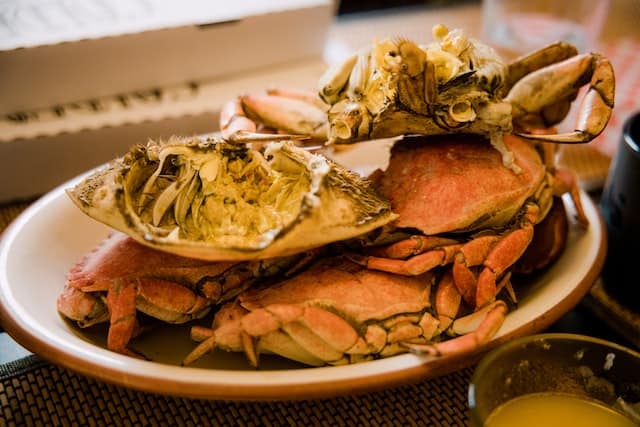Crab butter is a rich greenish-yellow substance found in the central part of a crab’s body cavity, although it can still be found in other arthropods like lobsters and shrimps but in a much different location.
It is a popular delicacy among seafood lovers, packed with flavor and nutrient and is incorporated into a wide variety of uses.
In this article, we’ll explore what crab butter is, what it looks like as well as some of its unique characteristics and properties.
We’ll also be discussing some of the health considerations associated with consuming it and how you can start using it in your kitchen to take your seafood game to the next level.

What is Hepatopancreas: Crab Butter?
Hepatopancreas is the greenish yellow substance (organ, when not heated up) in crabs and other arthropods that seafood lovers have come to know as crab butter.
Biologically speaking, it is a gland, a multi-functional one for that matter. And it helps organisms that have it (such as arthropods and molluscs), perform functions related to the digestion of food and absorption of nutrients.
The gland helps to produce digestive enzymes through a major subdivision of it called the Hepatopancreatic duct, which helps to break down food eaten by the crab into smaller particles that can easily be absorbed by the body.
Another division of it called the blind sac helps with nutrient absorption by extracting the nutrients from foods broken down by the hepatopancreatic duct in order to be transported into the crabs body.
In short, the hepatopancreas is a gland that functions much like the liver and pancreas in humans and other animals that have it.
The Unique Properties Of Crab Butter
To start with, crab butter is soft and creamy in texture, (just like butter), and its color is greenish-yellow. It is a rich substance with a taste described as slightly nutty plus a hint of brininess (for the fact that it came from a creature that lives in saltwater).
Some people may like the flavor while others won’t. In fact, some describe the butter as the most flavorful part of the crab.
Depending on season, species of crab as well as freshness of the crab, the taste of the crab butter may vary from flavorful and interesting to strong, overpowering, buttery and less interesting.
Potential Risks Involved With Consuming Crab Butter
As with anything food, the consumption of crab butter doses have its own concerns.
This time, it’s mostly centered around the accumulations of the hepatopancreas during the lifespan of the crab rather than its nutritional content.
As crabs live primarily in and near water bodies, and the hepatopancreas is primarily tasked with the job of breaking down foods and absorbing nutrients, it could, overtime, endup collecting toxins, carcinogenic compounds as no well as other harmful compounds from algaes and pollutants flushed out into the water.
These compounds, if present in large quantities, can cause negative side effects to the person consuming the butter.
However, it’s a bit rare to have crabs accumulate so many toxins (and in large quantities) in their hepatopancreas such that it would prove fatal or accumulate in the human body and present health effects.
Still yet, ensure to consume crab butter only in moderation and make sure the crabs themselves are collected from areas that do not have a long standing record of algae bloom or pollution.
How To Eat Crab Butter
If you are tickled by the idea of eating crab butter, below are some of the interesting ways you can incorporate it into your diet.
Try it on its own
One of the bold and adventurous ways to try crab butter is on its own, and even better is right from the back of the crab!
Take a gulp of the butter in the original state that it comes in and get the full brine experience!
Of course, crab neophytes would quake at such a prospect, but once you go crab butter, you never go back! You can even try it with the roe if you’re dealing with a female crab that has it in her cavity.
Try it with bread or crackers
The crab butter can be both pasty and liquid.
You might feel a certain way applying the butter directly on your bread, but you can collect the more solid form of it stuck inside the shell and spread that on your bread, sandwich or crackers just like you would spread a leftover rotel dip on a sandwich.
That way, you’ll be able to savor the rich and brine flavor of the butter.
Use it to make a dip
One great way to propose the liquid crab butter is to use it to make a dip.
Simply mix it into your favorite dip recipes to create a delicious dip that tastes and smells of seafood. Serve it with biscuits, bread and snacks like pigs in a blanket.
Use it as a condiment
In addition to using crab butter to make a dip, you can definitely use it as a condiment for other seafood dishes such as grilled lobster and fish or even the picked crab meat itself.
You can also use it as a sauce for rice or pasta. It’s even possible to substitute it for the gravy on mashed potatoes, the possibilities are endless, and everything really depends on how adventurous you want to be, and how willing you are to discover new flavors!
Use it as a cooking ingredient
You can also use crab butter as an ingredient in cooking so as to instill the traditional seafood flavor in whatever you’re cooking or baking.
You can use it for soups, stuffed mushrooms, seafood risotto, crab cakes, sauces etc.
Using crab butter at home is an exciting prospect for any seafood lover and anyone who wants to kick start their seafood adventure, but one thing is definitely a must when it comes to enjoying the right kind of butter: that’s getting the right quality first.
If you start out with a bad quality butter, then you won’t enjoy it as much and your first time trying it might as well be the last.
Make sure to opt for fresh crabs or those that are alive as they’ll have butters that are really fresh.
When you’re done using the butter and are left with remnants, store it in the refrigerator and consume within 2 days for maximum freshness and flavor.

